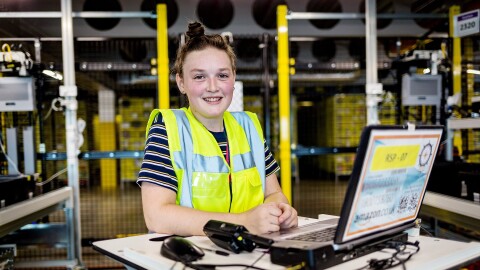Whether it's a last-minute birthday gift or groceries for tonight's dinner, you know that your Amazon order will be at your doorstep when you need it. How does Amazon pull that off? The answer involves a combination of advanced logistics, innovative technology, and dedicated associates.
Say the chilly weather prompted you to purchase a wool blanket from a home decor seller. Chances are, the blanket will come from a shop making use of Fulfilment by Amazon. Small business owners, once able to sell only locally, can now utilise Amazon’s marketplace and ship inventory to fulfilment centres, which handle the rest. As a result, home decor boutiques can reach customers like you all over the country. In fact, at least half the items sold on Amazon.co.uk come from entrepreneurs like this.
The following is a detailed look at how that blanket you ordered on Amazon.co.uk makes its way to you.
Filling the order: fulfilment centres
It all starts in Amazon's fulfilment centres, where products come in on lorries and travel inside on conveyor belts, beginning their journey to you. A surprisingly efficient process kicked into gear once you ordered your blanket. Stowed randomly with millions of other products—a method that ensures a wide variety of items lie close at hand—the product is whisked to an associate for picking via orange robotic drive units that move inventory around the centre.
After the blanket is picked, it moves along conveyors for packing. Along the way, a computer system scans and tracks progress, weighing the box once it's packed to ensure the order is correct. Once labelled, the box is sent to a waiting lorry based on shipping method, speed of delivery, and location.
Hitting the road: lorries
Amazon lorries, carrying more than 2,000 boxes at a time, bring orders from fulfilment centres to sortation centres, where packages are distributed by location and the required delivery speed. From here, they could be loaded onto a variety of transportation modes, from Amazon lorries and planes to carriers such as Hermes, DPD, and the Royal Mail.
Airborne: Amazon Prime Air planes
Charged with meeting Amazon's two-day delivery window for Prime members, Amazon Air planes take flight from over 20 airports around the country. Packages on these aircrafts are placed onto metal containers called Unit Load Devices, which can hold hundreds of boxes apiece in artfully slotted stacks. Each plane has the capacity to carry 30 or more containers—the equivalent of more than 10,000 Instant Pots. To see the loading process, check out how to pack a Prime plane.
Ground force: Amazon Delivery Service Partners
The volume of orders is so vast that Amazon is recruiting Delivery Service Partners to help get orders where they need to go. The partners hire and develop their own teams of drivers, operating with anywhere from 20 to 40 vans and 40 to 100 employees, while Amazon provides training, a comprehensive toolkit, and ongoing support. Amazon also uses independent contractors through Amazon Flex.
Flying toward the future
An array of sophisticated tools helps move your order quickly and efficiently, and the technologies behind them are constantly evolving. Amazon continues to explore new ways of getting products to customers, rolling out the next generation of robotics for fulfilment and developing unmanned aerial vehicles (also known as drones) that can fly packages right to your door.
Considering how quickly your orders are arriving with the systems Amazon has in place today, just imagine how quickly you'll be cosying up with that blanket in the future.











